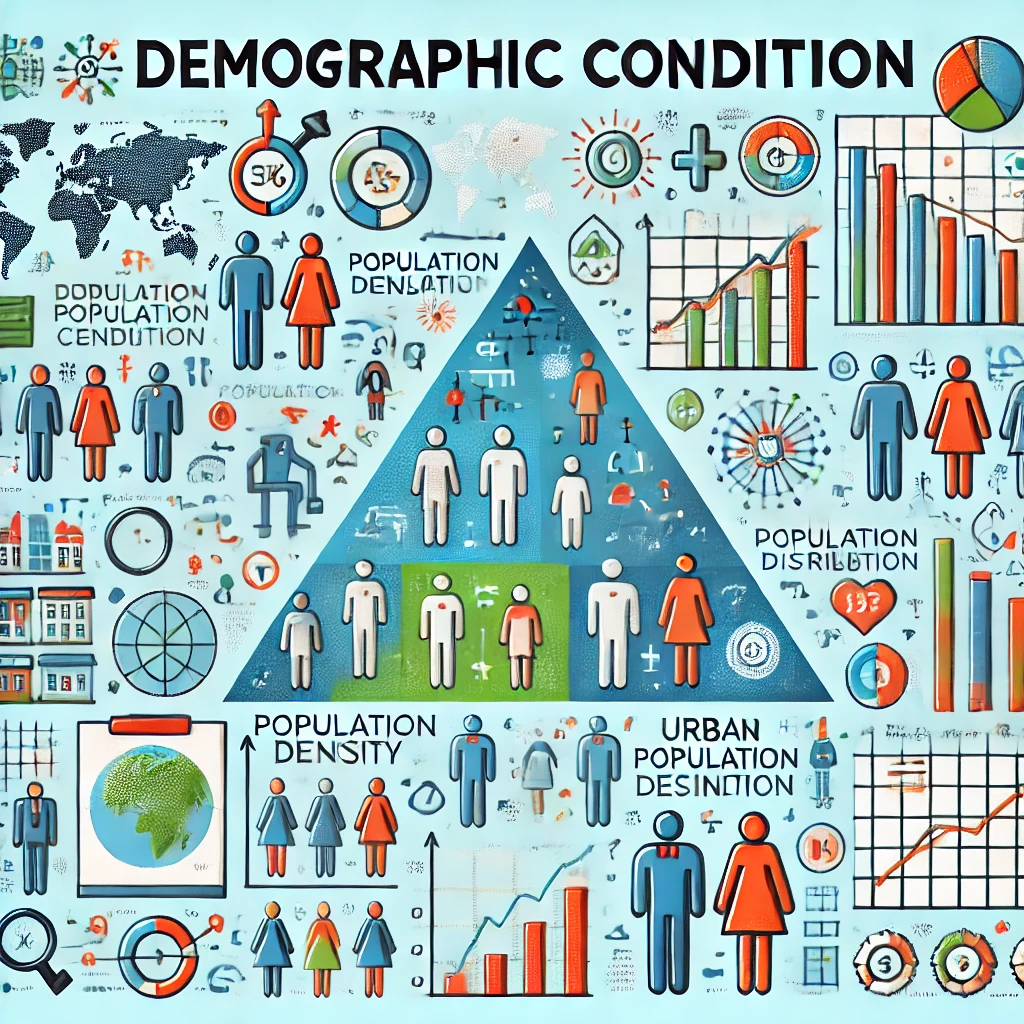Demographic condition refers to the statistical characteristics of a population in a particular area. This includes aspects like age, gender, income, migration patterns, and population density. The features would reveal the social, economic, and health status of the population. The importance of demographic conditions in determining the overall development of an area is evident from this fact. By understanding demographic conditions, the policymaker can plan infrastructure, education, healthcare, and other economic policies that may shape the future.
Demographic Condition Meaning
The demographic condition of a region or country encompasses its population’s structure and dynamics. It considers various aspects, such as population size, distribution, density, and growth rate, and key characteristics such as age, gender, race, employment status, and education levels. Demographic conditions are very important indicators for understanding the challenges and opportunities a region faces.
Usually, censuses and surveys constitute sources of demographic data used by the government in determining policies in social services, economic development, and even national security. For example, understanding the age distribution of a population will aid the government in planning its healthcare, education, and pension schemes. The condition of the population’s demographics provides an overview of population health, wealth, and social problems in a particular region.
Several key factors influence demographic conditions, including:
- Birth Rate and Death Rate: These rates determine how much a population increases or decreases in a given period.
- Migration: This is the internal and external movement of people, which can change the demographic configuration of a region significantly.
- Life Expectancy: It is the average number of years a person is likely to live and is the most important indicator of health condition in a region.
- Fertility Rate: The most important factor in determining future population growth.
- Age Structure: The age structure in turn determines labor force participation and education as well as the health care services required.

Demographic Condition in British Rule
Colonial policies, economic structures, and social conditions created the demographic condition of India in the 19th and early 20th centuries. British rule made many changes in Indian society, which had lasting effects on its demographic trends.
During the colonial period, the British focus was on economic exploitation, which had significant consequences for India’s population. Land revenue systems like the Permanent Settlement and Ryotwari system led to widespread poverty, famine, and displacement, which affected the population growth rates.
The high mortality rate caused by famines and diseases is among all such far-reaching consequences of British rule. Famines, in fact, killed millions, like the Great Bengal Famine of 1770 and the Famine of 1943. They have severely hampered population growth and brought an alteration in the demographic condition of large parts of the country. The immediate needs of the population often gave way to their economic interests.
In addition, the British colonial government introduced several taxes and policies that affected agricultural productivity, leading to the poverty of the masses. This led to low life expectancy, especially in rural areas. Western medicine reduces some infectious diseases, but it is not sufficient to counterbalance the impact of famine and malnutrition on the population.
Profile of Demographic Condition Under British Rule
During the period of British rule, the Indian demography exhibited a lot of peculiar features, such as a high mortality rate, slow population growth, and an agrarian economy. The preceding factors describe an impression of a stagnant or declining population, mainly when there were famines.
High Mortality Rate
One of the salient features of India’s demographic condition under British rule was that the mortality rate was very high. This was primarily because there were frequent famines and a lack of modern medical facilities.
Besides famines, India faced endemic diseases like cholera, smallpox, and malaria, which further elevated the death toll. Besides introducing some modern healthcare measures like sanitation improvements and vaccination programs, the British were unable to make these widespread enough to combat the high mortality rates in rural areas.
Population Growth and Decline
While India’s population did grow under British rule, the growth rate was much slower than it otherwise would have been because of the high mortality rates. Census data indicates that the population of India was roughly 100 million at the beginning of British rule in 1757. India’s population had grown to approximately 300 million by the time India gained independence in 1947, which suggests a relatively low growth rate relative to other nations. This was contributed by the high death rates, poor economic conditions, and inability to reach the necessary quality health facilities.
Migration and Urbanization
British colonization led to several internal migration patterns that, in turn, affected the demographic conditions of different regions. British economic interests exploited rural areas, leading to a mass movement from villages to cities. Under British rule, urbanization in India was at its bare minimum, and even industrial centers like those in Bengal and Bombay (Mumbai) were more extraction and export sites rather than urban development sites.
But it is not so that only economic migration occurred, as famines, wars, and colonial policies created large-scale displacement. Compulsory migration, like taking prisoners to penal colonies, changed the population profile of some areas.
Gender and Family Structures
The British period also changed family structures, though perhaps less directly. The impact of British rule on family life was mainly through their indirect control over social practices and norms. Education for women was practically nonexistent in rural areas, and gender inequality remained entrenched during this time.
The British did not intervene much in cultural practices such as child marriage or dowry, which were significant aspects of Indian society during that period. Now, though the British did some reforms like banning Sati and legislation to curb child marriage, demographic changes within the family structure were minimal compared to the socioeconomic changes.
Demographic Condition FAQs
What was the demographic condition in India during the British rule?
During British rule, high mortality rates in India were marked by frequent famines, diseases, and poverty. The population grew slowly, with large-scale displacement and migration patterns, but it was hindered by colonial policies that primarily focused on economic exploitation.
How did the British rule impact India’s population growth?
British rule significantly impacted India’s population growth by imposing economic policies that led to famines, poverty, and widespread diseases. Adverse factors caused the growth rate of the population to be slower compared to other regions despite growth occurring over the period.
What were the primary causes of high mortality rates in India during the British period?
Famines, diseases, and a lack of proper healthcare infrastructure caused the high mortality rate in India during the British period. Famines like the Great Bengal Famine and diseases such as cholera and malaria were primary contributors to the high death toll.
Did British colonial rule lead to significant urbanization in India?
Urbanization was limited in India during British colonial rule. Developers developed most cities for economic exploitation and not for the improvement of living standards. There was some internal migration, but overall urban development was slow during this period.
How did British policies affect Indian social structures?
British policies affected Indian social structures by enforcing economic exploitation, which exacerbated poverty and social inequality. Although some social reforms were implemented, such as the abolition of Sati and child marriage, these did not substantially alter the demographic condition of the population.

